Athena Wisniewski Copywriter / Copy-Editor Description: Portfolio contains articles that I wrote and edited during my employment with a national corporate recruitment firm. Contact me: Athena Wisniewski amw4hire@gmail.com 631-672-0792

Whether you are currently employed and looking to advance your career, or unemployed and seeking a new job, networking frequently plays a major role in the outcome. In fact, the right networking strategy can even decrease the overall amount of time spent on your job search, automatically increasing your chances of finding a better role. While mastering the art of successful professional networking may seem somewhat arduous, the truth is that once you take control and isolate your best approach, you will find that your job search efforts are instantly amplified. The goal is to build relationships, demonstrate your talents, and convince others of your value as a potential member of their team. In this way, when a desirable role becomes available, you will be among the first wave of candidates considered for either interview or recommendation. Hence, what strategies should job-seekers put into place when implementing a new plan for networking? Sustaining on social media Twitter, Facebook, and especially LinkedIn, are considered the “big three” when it comes to networking on social media. Professionally speaking, however, LinkedIn is at the top with over 546 million users worldwide. Nevertheless, each holds their own set of benefits, offering users the opportunity to successfully promote their personal brand while connecting with prospective employers. Twitter. If you are engaging enough, the brevity of Twitter almost assures that others will take the time to read your posts. The platform also makes it easy to reach out to those you admire in your field. Furthermore, recruiters and employers also make use of Twitter by posting jobs directly to the site. So, by following the right companies and searching applicable hashtags, job-seekers can view and apply to an abundant number of open positions. Facebook. In terms of professional networking, Facebook is often overlooked, despite the fact that it usually appears among the first results in most personal internet searches. More than simply an opportunity to post pictures of your last vacation, Facebook contains a myriad of professional groups to be searched and utilized. By creating a dynamic profile that demonstrates only your best and most applicable characteristics, you can begin to connect with important players in your field as well as companies of interest. In fact, in February 2017, Facebook launched a job search tool where companies can post current openings, easily accessed by users of the site.

LinkedIn. As the largest of all professional networking sites, LinkedIn is considered the leading online source for recruiting. Creating a comprehensive profile and keeping it upto-date will help you effectively participate in the social business forum, making the connections necessary to be noticed by those who are hiring candidates of your caliber and capability. A closer look at LinkedIn Widely understood and accepted as the primary professional networking social media source, LinkedIn is a dynamic tool that allows you to see and be seen. The tool itself allows you to interact globally, controlling the amount and type of information you wish to share. The networking experience. While LinkedIn as a platform is wide-casting, it is still directly keyed toward the business realm. Consequently, the connections you make are not simply general associations, but rather a genuine expansion of your professional network. Similar to any relationship, whether virtual or real-world, it must be fostered and maintained in order to remain afloat. Job seekers should keep in mind that merely existing on LinkedIn is just not enough. Take the time to post pertinent information, “like” and share the relevant posts of those you follow, and write endorsements. Most will find that their efforts will be not only welcomed, but also returned. Remaining in the spotlight. According to “U.S. News and World Report”, approximately 95 percent of recruiters use LinkedIn to screen potential job candidates. This means that a typical active LinkedIn member stands a considerable chance of catching the eye of an influential decision-maker in their field. Therefore, get to know the market niches of your professional connections so that you can properly tailor your content and activity to appeal to colleagues of interest, despite how far removed they may be in your network. If you make this part of your daily routine, your extended network will become increasingly familiar with your name, content, and personal brand. More than a “numbers game”. While building a large network on LinkedIn is certainly advantageous, this alone will not necessarily yield results in the form of employment. The concept of “quality over quantity” certainly applies when perfecting your LinkedIn networking skills. Just as racking up a high number of followers on Twitter or Instagram is not going to result in 3,000 meaningful connections, LinkedIn members must take into account the importance of selectiveness. From the information you choose to share to those you decide to connect with, be sure to always assess the impact your actions will have on your ultimate career goals. Face-to-Face Networking Although online networking is a must for professional job-seekers, the power of in-person networking is still quite significant. As a matter of fact, the word-of-mouth method is still an active and viable job search technique. In addition to being equipped with an ample supply of
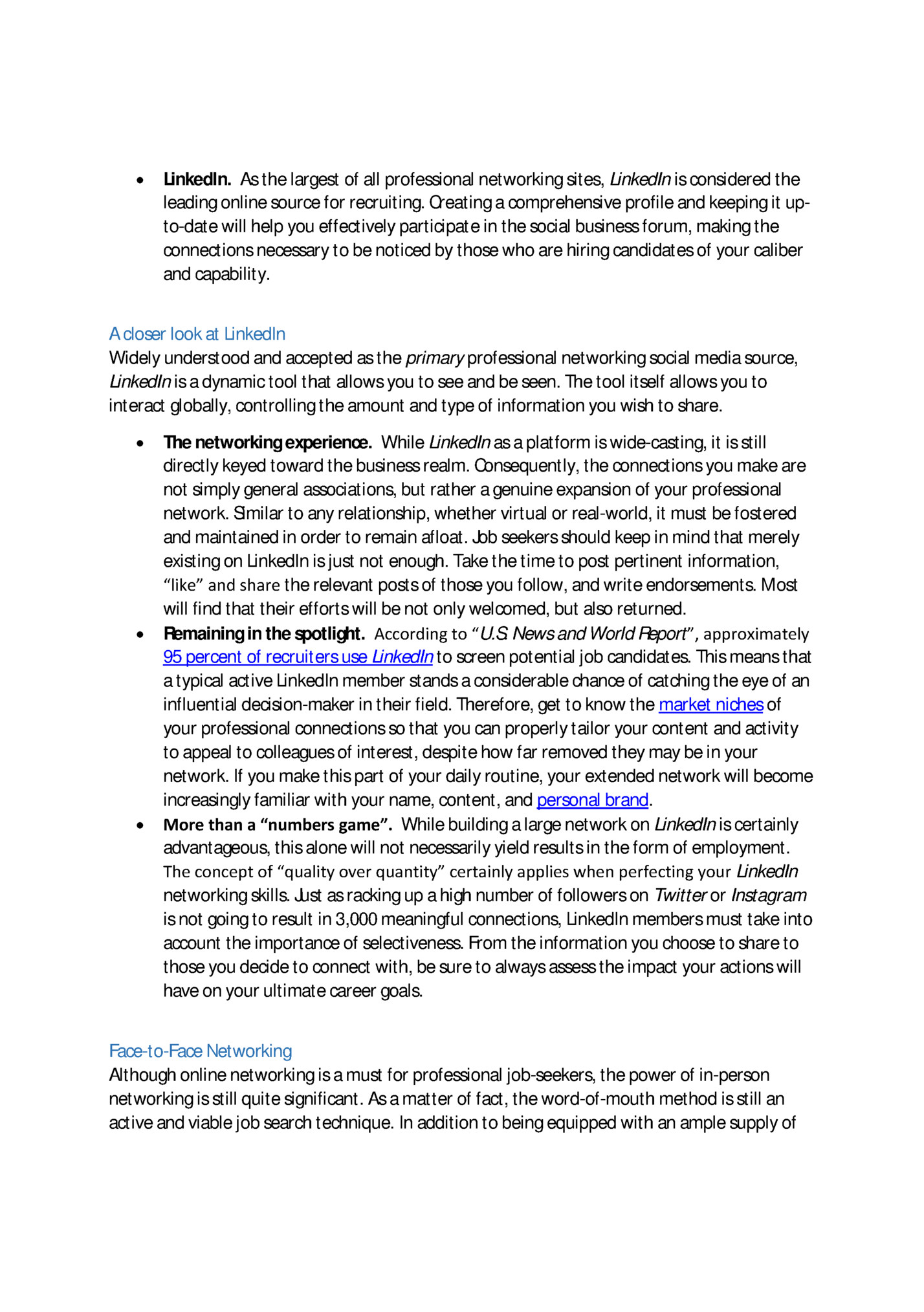
level? Join a professional alliance. Locate and research any association, organization, or alliance that is associated with your field or industry. Choose one, and learn how to become a member. Many associations encourage certifications, while holding periodic events and meetings for members. This is a perfect way to not only learn more about your industry, but meet other leading contributors in your field. Visit a local networking group. Whether an economic development organization, chamber of commerce, or any other type of networking group, chances are your city has at least one. Joining will offer you the opportunity to meet with referral partners, who, while not necessarily affiliated with your particular line of work, may have connections to others who are. Referral partners are typically well-connected within the community and often gain knowledge on job opportunities before the general public. Meet for lunch or coffee. Use your breaks or downtime to connect with former colleagues, team members, or any other professional allies within your community. Schedule a time when you both are free to meet for lunch or coffee. By doing this even one time per week, you will begin to notice the benefits of learning more about these individuals on a one-to-one basis. Remember to be tactical when deciding who to ask and how to fill your calendar. If you are conducting a discreet job search, meet with only those whom you know you can trust. In general, be sure to connect with people who are knowledgeable in your area of employment. Staying connected with former colleagues Even if your last position posed significant challenges, it’s important to remain on amicable terms with your former colleagues. Avoid speaking negatively to others about previous employers at all costs, whether in-person or on the web; and always maintain an optimistic demeanor at all networking events. Positive references and recommendations are a must when seeking new employment, so be sure to never “burn your bridges”. Maintain professionalism. Whether meeting for coffee or at a formal event -- or even promoting your personal brand online -- the first impression you make is the one that will be remembered. Dress appropriately for your line of work, offer meaningful input toward conversations, and uphold professionalism in your general decorum both in person and on the web. Try to imagine yourself from an employer’s perspective, and be sure that the connections you make are aware of your jobseeking goals.
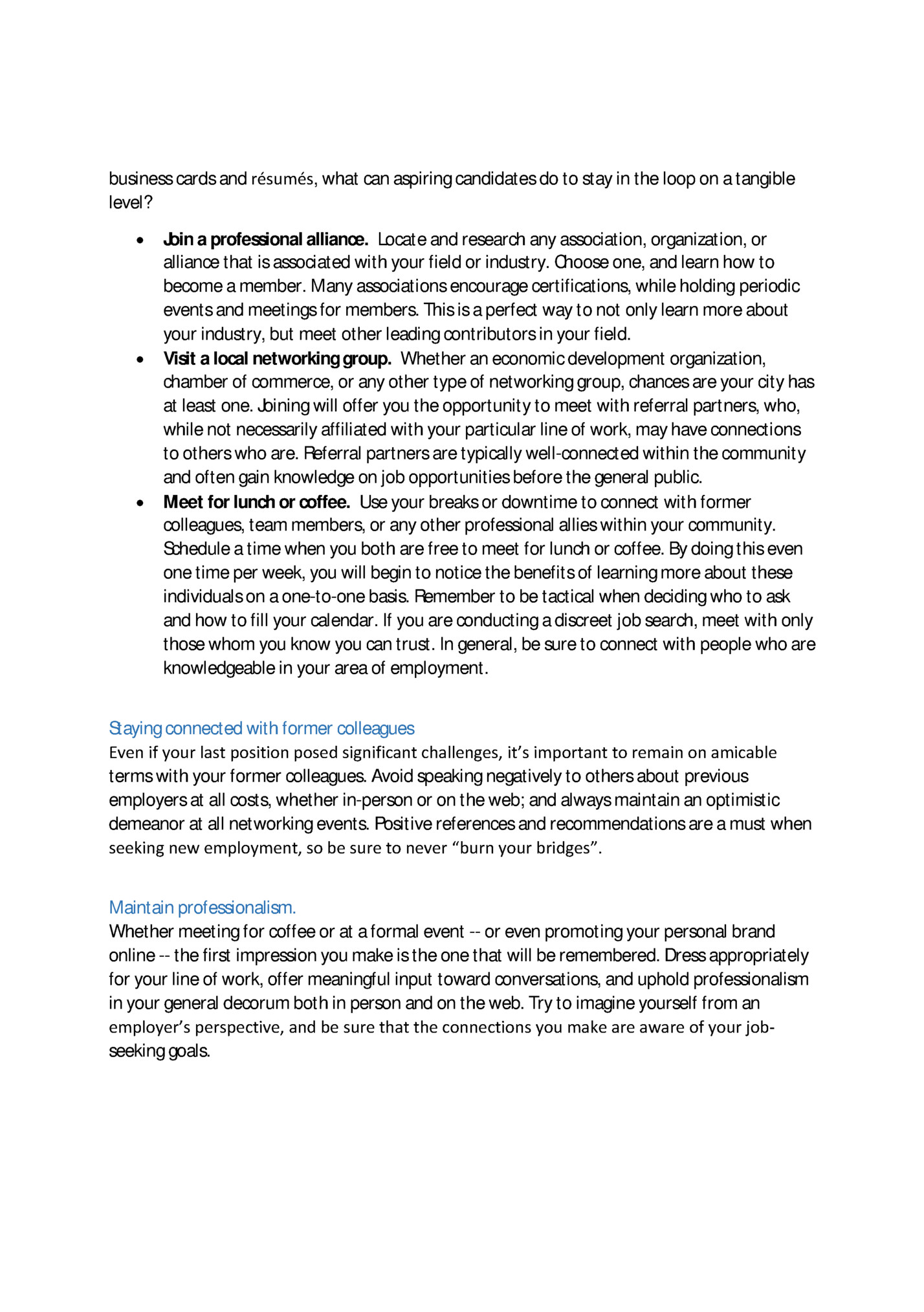
If you are an active job seeker, you may have found that interviews can arise in various forms and configurations. These differences are often affected by your particular field, industry, and even location. The key for job candidates is to not only have an understanding but also the tools to tackle the next interview they encounter; despite its format. Here is a list of the most common (and some less common) interview styles that candidates should be prepared to face during their job search, as well as some basic strategies for success. Traditional Interviews This most frequently encountered scenario includes a face-to-face meeting with one interviewer who asks a series of questions formulated to help determine whether or not a candidate is a suitable fit for the job. Those expecting to encounter a traditional interview should be prepared to answer inquires based on their past accomplishments, applicable skills, work history, education, and goals. Furthermore, job candidates must be ready with their own set of questions to ask at the end of the interview. Examples may include: What does a typical day entail? What are the attributes of an ideal candidate in this specific role? What are some of the biggest challenges someone in this position may face? What is the training process for this role? Phone interviews While often referred to as a phone interview, this type of meeting may be better described as a firstround screening. Specifically, a successful phone interview should ideally lead to a face-to-face interview. While they may share some key similarities with traditional interviews, there are certain factors that job candidates should take into consideration in order to ace a phone screening. For example: Work out any details such as time zone differences. Prepare notes and make sure to have them with you (along with your resume) at the time of the call. Be ready with a fully charged and working phone as well as a quiet location. Try writing down two or three of your best qualities at the top of your note paper. If you get nervous or begin to feel flustered, refer back to these keywords and remember why you were contacted by the employer in the first place. Wait a couple of seconds before responding to your interviewer’s questions to ensure you don’t end up speaking at the same time. This can also help you form a better quality answer. Remember not speak too fast. Sometimes in high-tension situations, our speech can become rapid, so ensure that you annunciate clearly.
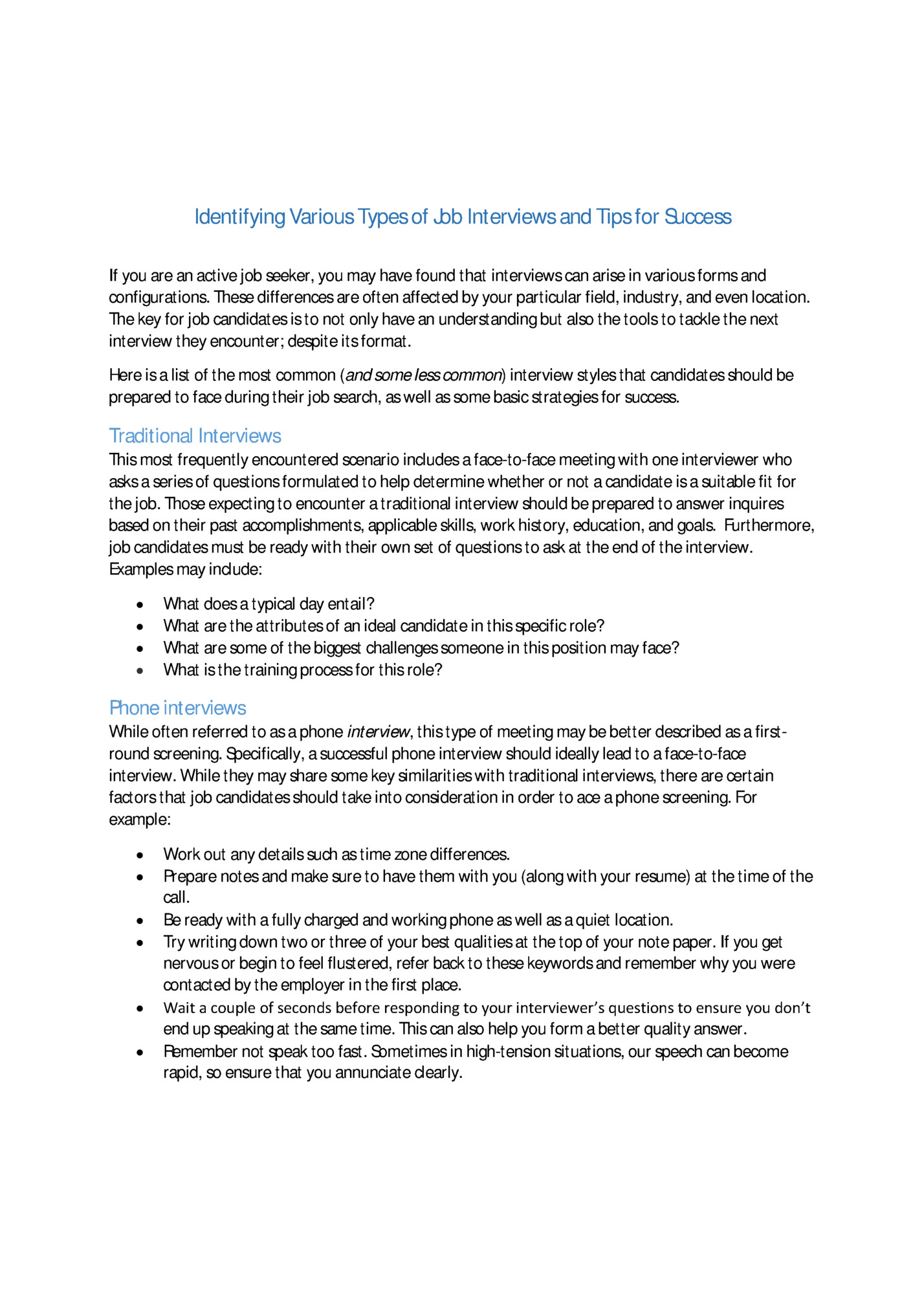
A step beyond the phone screening interview, Skype video interviews allow employers and job-seekers to connect on a face-to-face basis from long distances. Candidates who are planning to relocate to a distant locale for new employment may find themselves encountering a video-style interview. Here are some aspects that job candidates should keep in mind prior to a Skype interview: Be sure your internet connection is secure and in working mode. Arrange for a neat, non-descript background when setting up your web-cam. Dress as professionally as you would for a traditional interview, but avoid overly bright or distracting colors or patterns. Ensure that you are prepared with all necessary materials (resume, writing tools, etc.) so you do not have to pause the session for any reason. Practice effective and positive body language, such as the “digital handshake” which is an engaging nod of acknowledgement upon facing your interviewer and before signing off. Speak clearly and maintain appropriate eye contact. Case Method Interviews Case study questions first merged with the interview world by way of management consulting firms, and are now frequently utilized by some of the largest city firms in the U.S. The purpose of case study questions is to assess a job candidate’s problem solving abilities, analytical skills, and creativity. Additionally, case study questions can help give employers a better understanding of candidate’s business sense and ability to interpret data. Case studies exercises can be performed within a small group, written, or computer simulated. Examples of case method interview questions may include the following: An established business wants to expand and develop its online presence. What is your advice? A well-known restaurant chain is pulling in less-than-adequate revenue. What are your suggestions for improvement? A company discovers that its annual revenue is at an all-time high, yet the company still operates at a loss. What could be the reason for this? Job candidates who are participating in this type interview are best advised to take notes, identify and prioritize key issues, and work to stay on topic without becoming side-tracked by real-world industry discussion unless specifically asked to do so. In addition, they should remember to speak clearly, be ready to justify main points, and recognize that there are no right answers, but simply different approaches to a common goal. Puzzle Interviews Competitive companies like Google have been known to incorporate what are known as “puzzle” questions when interviewing candidates. For example, a random inquiry such us, “How many people in New York City can be expected to log onto Twitter at 4:00pm on a Friday?” is actually an effective way for an interviewer to determine a candidate’s ability to think on their feet and thrive under pressure. Tech related jobs are typically one of the more common industries where an interviewer may opt for the puzzle approach. To avoid getting flustered, job seekers must remember that the goal is to exhibit logical analysis, curiosity, and the ability to communicate clearly. In fact, these items may be

identify your capacity to use rational and working strategies to solve a problem. However, it’s important to resist the temptation to jump right in with an answer. Candidates should not hesitate to ask for a reasonable amount of time to work out their answers; perhaps creating a rough outline to assist with computations and estimates. Working Interviews Some employers prefer a more direct approach. Rather than simply asking you to explain why you’re the best match for the position, they want to actually see it. Writers, sales people, and engineers are among some of the professionals who may encounter a working interview. In this instance, an interviewer will request that a candidate display a specific job skill on the spot. However, candidates who are about to confront this type of interview shouldn’t panic, as there are certain strategies to make the working interview a more manageable experience. Don’t be afraid to ask questions such as how the assignment will be evaluated, how much time is needed for the assignment, and if there is any relevant data available that will improve the quality and accuracy of your assignment. Since the main goal of the interviewer is to assess your thinking and problem-solving strategies, try not to get overly caught up in minor details. Focus, rather, on main ideas with a bullet-point approach. Group Interviews While group interviews are considered somewhat uncommon, they mostly occur when companies are hiring for sales positions, internships, or any circumstance where several employees are needed for one project or job. The key to mastering the group interview (sometimes referred to as an audition) is to isolate which tactics will best help you to stand out. Candidates about to embark on a group interview should remember to display confidence, engage with the other interviewees, remain true to their character, speak with determination and purpose, and practice active listening during the meeting. Lunch interviews If a potential employer requests that you meet for lunch to discuss possible employment, this can be taken as a very good sign. Since your interviewer has chosen to learn about you in a zone separate from the office, you will need to discover the best ways to emphasize your professional accomplishments and strengths while in a non-professional environment. Job candidates should first research the location, and even assess the menu options, so that more time can be spent speaking about your job qualifications rather than deciding on your entrée. Since lunch interviews present a more conversational, even relaxed, atmosphere, remember to balance professionalism with a sense of personability. Nevertheless, a lunch interview can offer candidates the opportunity to display the best parts of his or her personality. On a side note, your prospective employer will be prepared to cover the bill. However, despite the comparatively laid-back environment, candidates should keep in the mind the importance of asking what the next steps will be following the meeting.
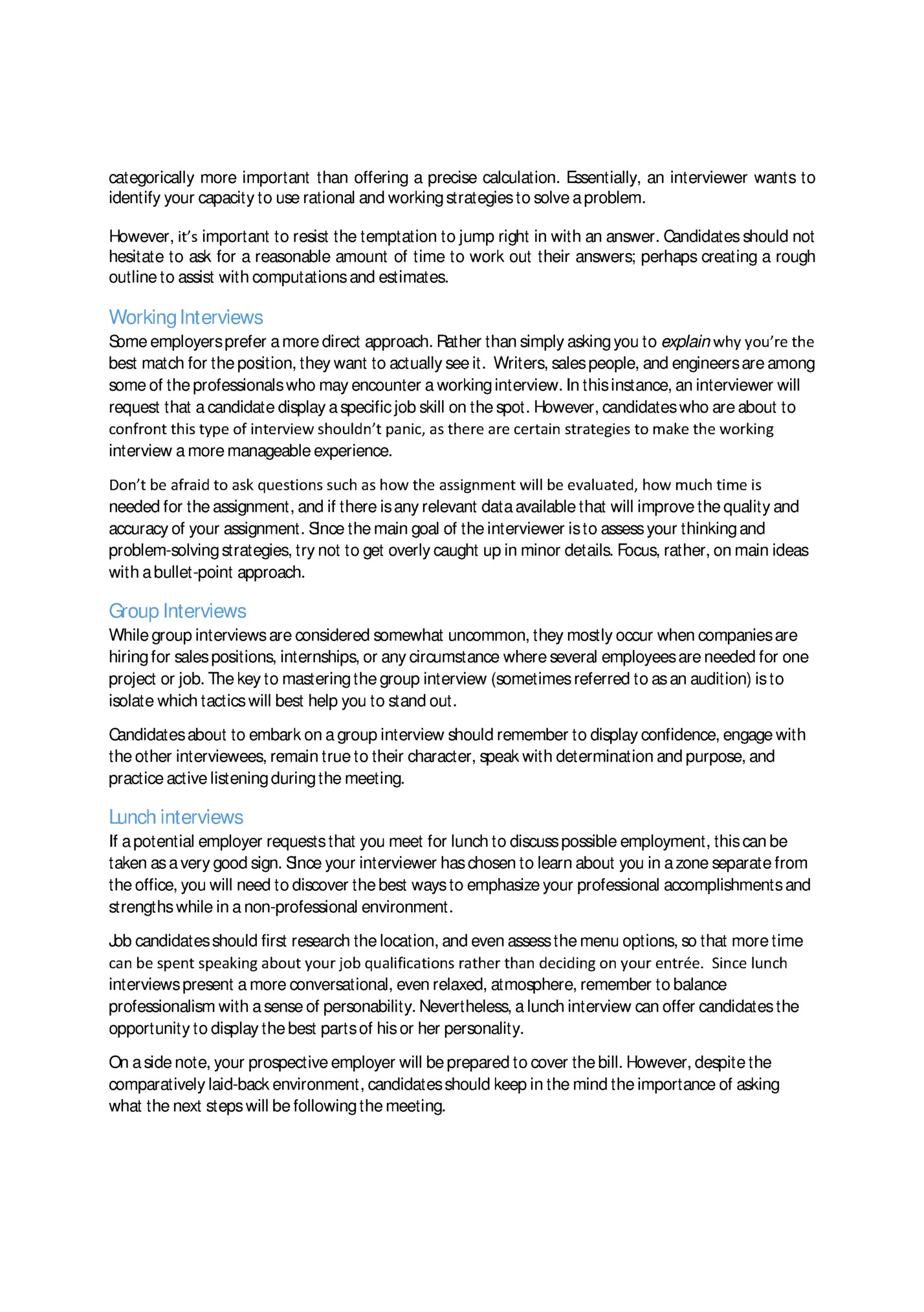
Sometimes referred to as a “firing squad” interview, some candidates may find themselves meeting with multiple interviewers simultaneously. While time efficient in the sense that it offers job candidates the opportunity to meet with several decision makers in one sitting (rather than returning for subsequent interviews), it can sometimes be challenging to make a sufficient connection with each interviewer. Fortunately, there are some useful guidelines for candidates who are facing a panel-style interview: Pay attention to the role of each panel member so that you will be able to better elaborate upon and individually direct your answers. Watch your body language by ensuring that you make eye contact with each interviewer, rather than solely focusing on one central person. Maintain a certain amount of control over the pace of the conversation by not rushing your answers. Arrive to the interview armed with a set of experience-related anecdotes in the event of followup questions by various panel members. Following up While the job interviews mentioned may all require varying styles of preparation, certain factors -which remain constant -- are the need for professionalism and a keen sense of perceptiveness. Also, be sure to follow up your interview with a thank you e-mail, letter, or phone call expressing your appreciation for your interviewer’s time. Briefly reiterate your interest in the position, and if sending a written communication, make sure to re-include your contact information.
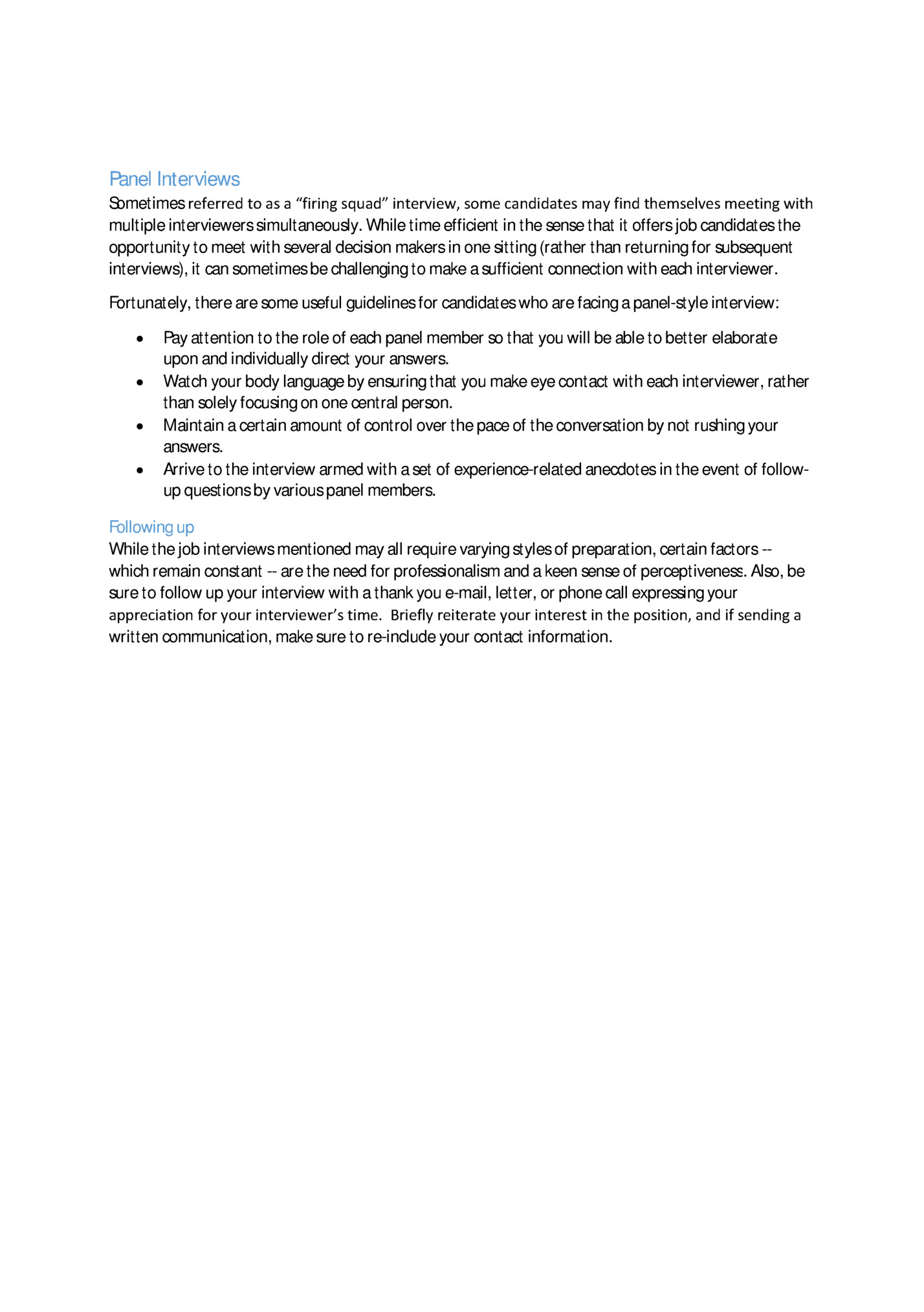
Professional Connections Since 2003, professionals across the globe have been using LinkedIn as their go-to site for networking, sharing ideas, recruitment, and talent branding. LinkedIn offers job seekers the ability to peruse and connect with companies of interest while employers have the option to search and screen for new talent. Today, with approximately half-billion members world-wide – and over 130 million just in the U.S. alone – one would be hard-pressed to find a Fortune 500 executive who is not an active LinkedIn member. In straightforward terms, if you are not on LinkedIn, you will certainly not be visible to potential employers, recruiters, and clients. Moreover, a noticeable lack of presence on the network can even translate into a form of uncertainly regarding your professional legitimacy and technical competence. Consequently, building a basic personal profile is the first step toward gathering the extensive benefits of LinkedIn. Your profile should spotlight your strengths, accomplishments, talents, and education. These main facets will help you become noticed by the colleagues and decisionmakers with whom you’ll have a greater chance of establishing a worthwhile connection. Following are guidelines for creating a results-driven profile on LinkedIn. Keep heading clear and concise. Your name, followed by any applicable suffixes or professional designations (MBA, PhD, etc.), proceeded by a subheading that suitably portrays your present career status is what should appear at the top of your profile page. Also, be sure to always include a professional looking self-photo. The amalgamation of these particular components will improve how your profile page appears in various LinkedIn searches. Don’t solely rely on your résumé. Your LinkedIn profile page offers the chance to expand and build upon the information that already exists on your résumé. Therefore, in addition to merely uploading your résumé, take advantage of the opportunities to add relevant documents, publications, and even supporting videos which can help you project your value to prospective employers. LinkedIn users should ensure that they take full advantage of each section that applies to them. Keep it positive. Professionals seeking employment – or any other type of meaningful business connection – should refrain from sharing overly-personal details or specifics that could be deemed as negative. Likewise, participating in dialogue concerning extreme or ‘hot-button’ issues is best avoided while job-seeking.
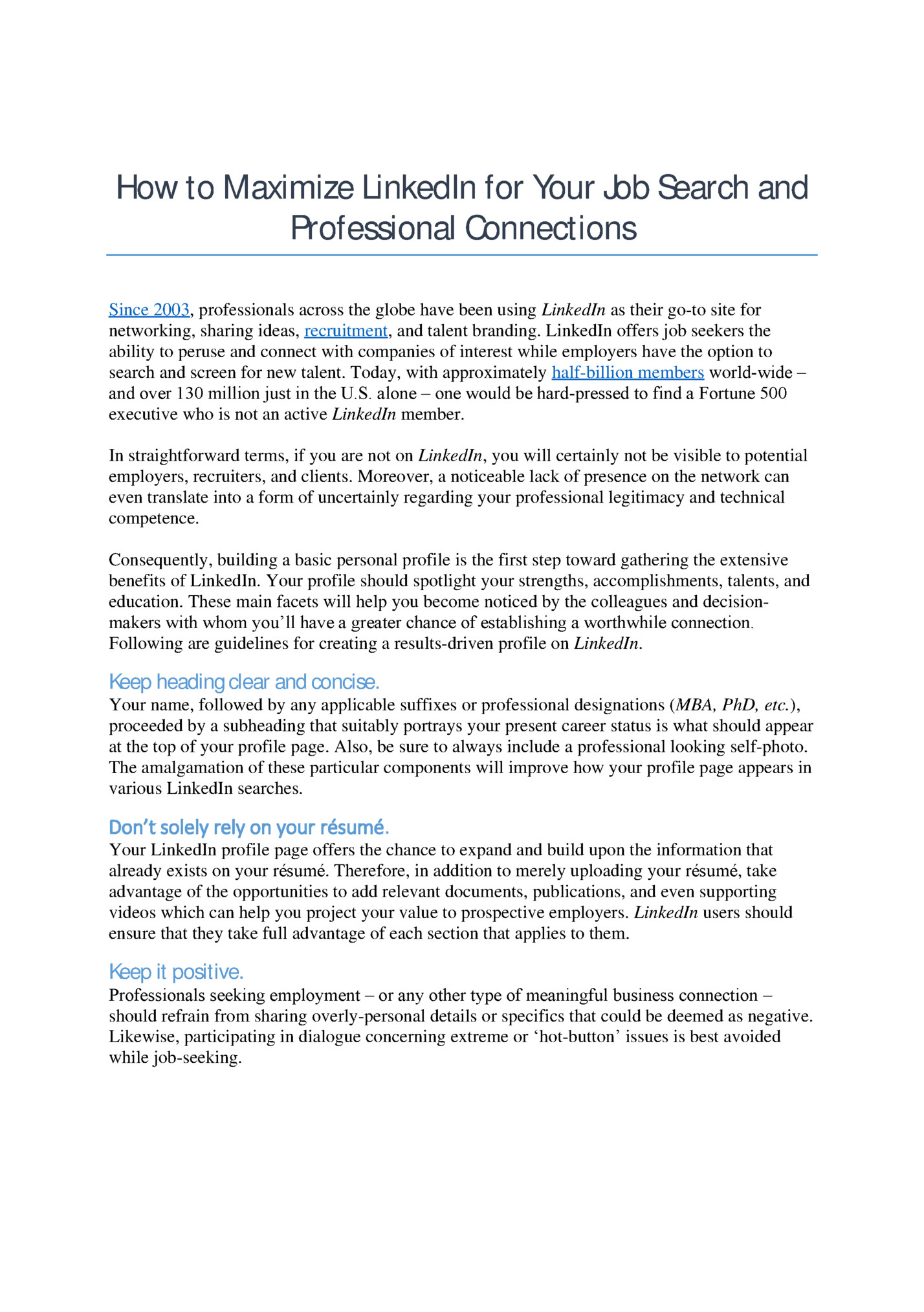
Fleepit Digital © 2021